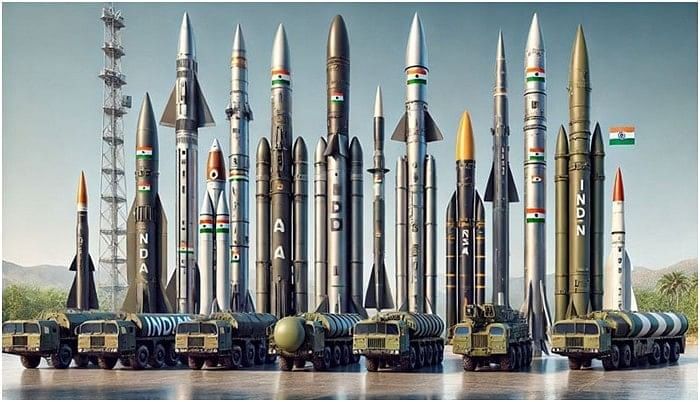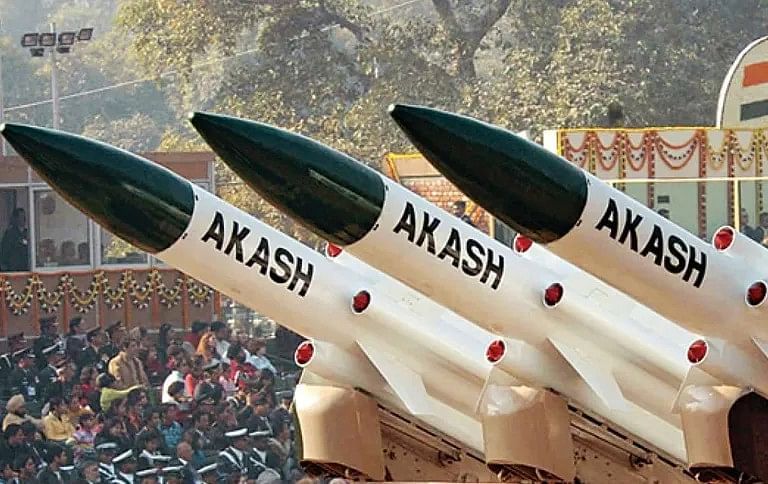Types of Missile | General Awareness for SSC CGL PDF Download
Introduction
Missiles are guided weapons designed to deliver payloads, including explosives or other warheads, to a specific target with high precision. They are classified based on their launch and target locations, propulsion systems, and operational roles.

Types of Missiles
Surface to Surface Missiles (SSMs)
Surface to Surface Missiles (SSMs), also referred to as Ground to Ground Missiles (GTGMs), are guided projectiles launched from various platforms such as handheld devices, vehicle-mounted systems, trailers, fixed installations, or ships. These missiles are designed to strike targets on the ground and are categorized into the following types:
- Ballistic Missiles: These missiles follow a high, arching trajectory, with the propulsion system typically burning out during the initial phase of flight.
- Cruise Missiles: These missiles maintain a relatively low flight trajectory and are powered throughout their flight. They usually have a range of around 2,500 km.
- Anti-tank Guided Missiles: These missiles fly close to the ground and may or may not have continuous propulsion. They are designed to target armored vehicles with a typical range of about 5 km.
- Anti-ship Missiles: These missiles travel close to the ground or sea surface and often perform a maneuver such as popping up or jinking just before hitting their target, typically a ship. They generally have a range of about 130 km.
Surface to Air Missiles (SAMs)
Surface to Air Missiles (SAMs), also known as Ground-to-Air Missiles (GTAMs), are designed to be launched from the ground to destroy aircraft or other airborne threats. The smallest of these systems are Man-Portable Air Defense Systems (MANPADS), which are lightweight and portable enough to be carried by individual soldiers.
India’s Missile Development Programme
India initiated a comprehensive missile development program known as the Integrated Guided Missile Development Programme (IGMDP) under the leadership of Dr. Abdul Kalam in 1983. This program aimed to consolidate the country's technological capabilities in propulsion, navigation, and materials manufacturing. Four key projects were launched under this program:
- Prithvi: A short-range surface to surface missile.
- Trishul: A short-range low-level surface to air missile.
- Akash: A medium-range surface to air missile.
- Nag: A third-generation anti-tank missile.
The program also led to the development of the Agni series of missiles, initially conceived as technology demonstrators and later upgraded to ballistic missiles with varying ranges. The Interim Test Range at Balasore, Odisha, was developed to support testing activities under this program.
Prithvi Missile Series

The Prithvi series, developed by DRDO, includes tactical short-range ballistic missiles (SRBMs) designed for battlefield use. These missiles are capable of carrying nuclear warheads.
Agni Missile Series
The Agni missile series began as a re-entry technology demonstrator and evolved into a family of ballistic missiles with different ranges. These missiles are equipped with advanced guidance systems, such as Ring Laser Gyro (RLG) based Inertial Navigation Systems (INS) and Micro Navigation Systems (MINS). The series includes:
- Agni-I: A two-stage missile with a range of 700-1,250 km.
- Agni-II: An improved version with a range of 2,000-3,000 km.
- Agni-III: A missile with a range exceeding 3,000 km.
- Agni-IV: Capable of reaching 2,500-4,000 km.
- Agni-V: An Intercontinental Ballistic Missile (ICBM) with a range of 5,000-5,500 km.
- Agni-VI: Currently under development, this ICBM is expected to have a range of 8,000-10,000 km and can be launched from both land and submarines.
Akash Missile System

The Akash missile system is a medium-range surface to air missile developed by DRDO, designed to engage aircraft up to 30 km away at supersonic speeds, supported by a phase-arrayed fire control radar known as Rajendra.
Trishul Missile System
Trishul is a short-range surface to air missile with a range of 12 km, intended for use against low-altitude targets.
Nag Anti-Tank Missile System
The Nag missile is a third-generation, fire-and-forget anti-tank missile designed for all-weather conditions. It has several variants, including:
- Land Version: Launched from a tracked vehicle known as NAMICA, using thermal sight and Imaging Infrared Seeker (IIS) for target acquisition.
- Helina: A helicopter-launched variant with a range of 7-8 km.
- Air Launched Nag: Designed for tactical interdiction aircraft with a range of 10 km.
- Man Portable Nag: A portable version under development, weighing less than 14 kg.
Strategically Important Missiles
Beyond the IGMDP, India has developed several other significant missiles:
- Astra: An active radar homing Beyond-Visual-Range Air-to-Air Missile (BVRAAM) with a range of 80-110 km and speeds exceeding Mach 4.
- Maitri: A short-range Quick Reaction Surface to Air Missile (QRSAM) with a range of 15 km.
- Nirbhay: A long-range subsonic stealth cruise missile designed to complement the BrahMos missile.
- Novator K-100: An Air-to-Air missile developed as an AWACS killer with a range of 300-400 km.
- Prahaar: A solid-fuelled short-range tactical ballistic missile with a range of 150 km.
- Sagarika / K-15: A nuclear-capable Submarine Launched Ballistic Missile (SLBM) with a range of 700 km.
- Shaurya Missile: A hypersonic surface to surface tactical ballistic missile with a range of 600 km.
- Dhanush: A naval variant of the Prithvi-II missile with an operational range of up to 350 km.
- Barak: A Surface to Air missile system purchased from Israel, designed to protect ships from aerial threats.
- BrahMos: A supersonic cruise missile with a maximum range of 290 km, capable of being launched from various platforms.
- Pranash: A ballistic missile under development with a range of 200 km, intended for tactical missions.
Ballistic Missile Defence Programmes (BMD)
India's BMD programs are designed to detect and intercept incoming ballistic missiles. Key components include:
- Prithvi Air Defence (PAD) / Pradyumna: An exo-atmospheric interceptor capable of engaging ballistic missiles with ranges between 300-2,000 km.
- Advanced Air Defence (AAD): An endo-atmospheric interceptor designed to neutralize ballistic missiles within the atmosphere at altitudes up to 30 km.
|
528 videos|2113 docs|339 tests
|
FAQs on Types of Missile - General Awareness for SSC CGL
| 1. What are the different types of missiles developed by India? |  |
| 2. What is the Prithvi Missile Series known for? |  |
| 3. Which missile system in India is specifically designed for anti-tank warfare? |  |
| 4. What is the purpose of India's Ballistic Missile Defence Programmes (BMD)? |  |
| 5. Which missile system in India is considered strategically important for national defense? |  |
















